Apert Sydrome: Treatment
Treating the Hands and Feet:
Parents are often anxious to have the fingers of their child with Apert
syndrome separated. The timing for this separation depends a little on
how the child's brain is doing and what needs to be done to the skull
(that is, skull surgery takes precedent over the hands and feet). I prefer
to have all the fingers separated by 18 months of age. This is to allow
the child to "learn" how to use their new separated fingers as soon as
possible. I prefer to separate all the fingers in two operations. I believe
that no fingers should ever be "thrown out," nevertheless; this remains
a standard recommendation by many surgeons today. It is almost always
possible to get 10 fingers, and I believe that that having a five-fingered
hand becomes increasingly more important to children as they grow older
(see
[ ]).
How about the toes? Separating the toes in a child with Apert syndrome
has generated a lot of discussion among families with children born with
Apert syndrome. To begin with, separating the toes does not improve a
child's ability to walk or run. In fact, it could be argued that the only
truly functional benefit to separating the toes is that it would allow
a child to wear "flip flops." I believe that it is very important to separate
the toes, if it doesn't add any additional operations. At our center,
we separate all 10 fingers and 10 toes in just two operations. As any
child needs two operations to separate all the fingers already, no additional
operations are being performed if the toes are done at the same time.
The reason I believe that it is important to separate the toes, is because
as children with Apert syndrome grow up, it is the appearance of the hands
and the feet that bother them the most. In fact, many children who have
not had their toes separated will not want to go swimming, go to the beach,
or take their shoes off to run in the grass, because of the embarrassment
they feel. Therefore, separating the toes does offer a very significant
"functional" improvement, because it helps the child to live a more normal
life. It is a common misconception that separating the toes widens the
foot. In fact, the skin bridges between the toes in no way helps to keep
the toes closer together. The width of the toes is determined by the way
the bones of the toes grow: the Apert foot grows wide because of the angulations
of the bones of the toes. The skin between the toes simply stretches out
with toe growth.
As stated above, all 10 fingers and toes can be safely separated in just
two operations, although this does take a highly experienced team to perform
this combined procedure. Usually, children just spend one night in the
hospital, and then go home the next day. We send the children home in
casts, which are removed about three weeks later (usually at home). After
three or four months, the second stage is done to complete the release
of all the fingers and toes.
After all the fingers and toes have been released, I have been performing
another series of operations on the hands and feet, usually when the child
is older than 10-years of age. At this time, bends are put in the middle
of all the fingers, and the thumbs are straightened. This allows the hand
to both function and look better. These procedures are especially useful
to help the child learn to button shirts, pull up zippers and tie shoes.
In addition, sometimes some of the "bumps" on the foot are reduced if
they are causing soreness, and the big toes can be straightened as well.
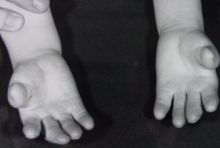 |
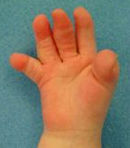 |
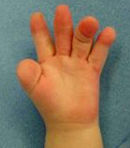 |
 |
| Examples of released
hands (Type I) |
| |
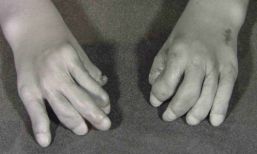 |
|
| Example of released
hands (Type III) |
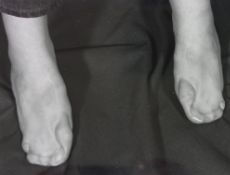 |
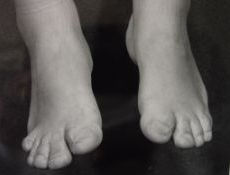 |
| Example of a patient
with un-released toes, and one in whom the toes have been separated. |
Other Apert Syndrome Treatments:
Skull Surgery
| Treating Sleep Apnea
| Midface Surgery
<<more about Apert Syndrome
|










